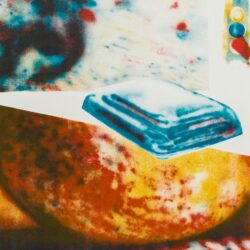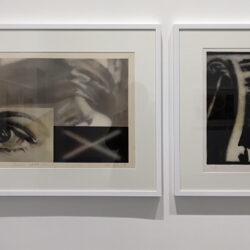“He was interested in the difference between noble matter and imitation, in the distinction of the authentic and the copy, and in the cases of reproduction, imitation, reality and its reflection, which were not always noticeable to everyone.” – recalled Stanisław Zbigniew Kamieński his memories on Péter Gémes’ early years spent Poland in 1988. Vintage Galéria’s current exhibition – borrowing its title from a piece made in 1979 – displays a selection from these works created between 1975 and 1980, seeking to expand the boundaries of painting, photography and graphics and addressing contemporary artistic subject matters.
Due to the principles of the Polish education system, in addition to his studies in graphics, Gémes also had to pursue studies in painting, and as part of his school assignments, experiment with photography, which also influenced his artistic practice. When making his prints based on photographs taken from magazines and brochures, and also keeping his eye on his own belongings, Gémes applied the ink to the surface of the lithographic limestone using the airbrush technique and thus eliminating personal contact. As a result of his partially painterly approach and the imitation of the peculiarities of optical imaging, he created technically outstanding, dissolved and subtly blurred surfaces in his lithographs in the spirit of some kind of individual “photo-vision”.
For Gémes, who was well-informed regarding the current international trends, but was still stuck on the periphery of both the Polish and Hungarian art scene in the Central and Eastern European region, his intimate „inner space” or – to quote the title of one of the works – Personal Interior (1979) became more prominent and enlarged in the second half of the 1970s, and so did the objects surrounding him. Playing along the imaginary rules of his Transpositional Exercises (1979), some elements of this world created by him can be interpreted in an extremely diverse way when we consider the all the global, regional, local and even individual contexts.
Rátkai Zsófia
Péter Gémes (1951-1996) visual artist. From the 1970s onwards, the works of Péter Gémes were related both to the contemporary Polish and Hungarian art scene, and to the traditions of international art. Gémes studied graphics at the Academy of Fine Arts in Warsaw between 1972 and 1976, and few years later he returned to Hungary. From the 1980s, he turned towards photography and developed his unique lighting technique, and created negative-like black-and-white shots of his own body and models. The starting point of his works in this decade was primarily ancient art and Greek mythology, then later philosophy and Christian symbols also became significant in his work. Inspired by these fields and utilizing his individual imaging technique, he was dealing with the universal issues of physical and mental existence, the intermediate state, the nature of the afterlife and darkness and light. In the 1990s, he created his large-scale systems from less and less recognizable elements still using images of his own body parts. His series and sequences were sometimes “spiritually” inspired (Apocryph, 1993; Black Square, 1993), and at other times abstract subject matters such as time appeared in them (Diary – One Week, 1994; Diary – Pyramid, 1995). These works, as well as the Columns (1995) series compiled from leg motifs, can be considered as a summary of his artistic practice spanning only two decades. Gémes’ retrospective exhibition was organized at Kunsthalle Budapest in 2000, his works can be found in the collections of the Ludwig Museum – Museum of Contemporary Art, Hungarian National Gallery (Budapest), Muzeum Sztuki Współczesnej (Radom) and Staatsgalerie (Stuttgart), among others.

